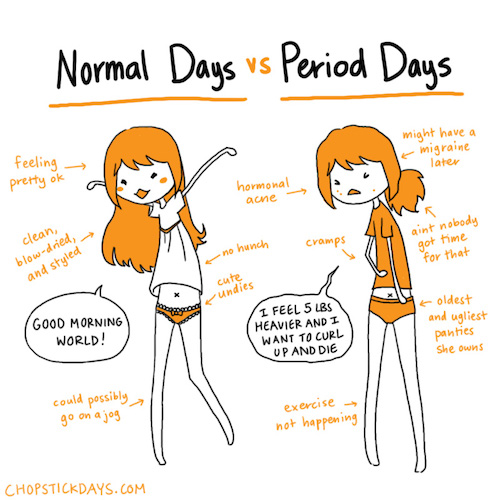Training and Periods!
Let's start with a topic not many like to talk about: menstruation. Why? Because it is something most women go through for most of their life, it's not often understood, and it can both positively and negatively affect your fitness training.
Women are unique in various ways to men, and yet these unique qualities are often misunderstood and not well researched. Both men and women have different hormones circling through their body, which affects everything from mood, metabolism, sleep, muscle growth, and exercise performance. A greater understanding of the patterns of our hormone levels may help women athletes and regular exercisers learn how to train appropriately at each stage of their cycle, and have a deeper connection to their body.
Women who ovulate experience fluctuations in strength, stress levels, mood, and appetite, depending to the stage of their menstrual cycle. Though it is often believed that symptoms are only expressed during a woman’s period, a woman’s cycle can affect her both negatively and positively at any stage of her cycle.
There are two main hormones than fluctuate massively during a woman’s cycle: Estrogen and progesterone. Estrogen is often viewed as opposite to testosterone and is explained as a large reason why men and women differ in their muscle strength and size. However, estrogen is not a blocker for muscle growth. It, in fact, can be viewed as an anabolic hormone, meaning it can increase muscle growth and repair.
When estrogen level is at its highest, women who train experience an increase in pain tolerance, endurance, and maximal strength. This occurs at the follicular phase (between day 7 and 14), and at ovulation. If you wanted to test your Personal Record (PR), this would be a good time.
After ovulation, women enter the Luteal phase (day 14-28) when estrogen levels drop and progesterone rises. This is where women may experience a decline in performance, feel stressed and tired, and experience PMS symptoms by the last days. Metabolism changes too: More fats and less carbohydrates are burned for energy. Endurance exercises, such as long runs, may appear less challenging and unaffected by this stage, but explosive and maximal strength performance might decline. As frustrating as it can be, know that these experiences can be due to your cycle. No one is saying that you cannot do heavy lifts at this phase, but respect your body and make sure you are not pushing yourself too far to risk injury.
What about during menstruation? This is when you are on your period and the cycle starts again - estrogen levels rise and progesterone levels normalise. Although you may feel that you want to curl up in a ball and skip the workout during this time, exercise can help relieve cramps and increase your energy. It can even boost your mood and reduce water retention and bloating. You may find bracing your core and ab exercises more difficult depending on the severity of your cramps, but most exercises should be fine. Your body temperature is also a bit lower than before, which can make working out in warm weather and at high intensities a little easier.
Do you find highs and lows in your training performance at different times of the month? Do you find it hard to exercise during your period, feel indifferent, or perform better?
Cheers,
-Florence
References
Barrie, 2015. https://www.health.com/menstruation/5-things-to-know-about-exercising-during-your-period
Bruinvels G, Burden RJ, McGregor AJ, et al Sport, exercise and the menstrual cycle: where is the research? Br J Sports Med 2017;51:487-488.
Body Form. 2016. https://www.bodyform.co.uk/our-world/exercising-during-period/
Lowe, D. A., Baltgalvis, K. A., & Greising, S. M. (2011). Strength in Females, 38(2), 61–67.
Phillips SK1, Sanderson AG, Birch K, Bruce SA, Woledge RC. Changes in maximal voluntary force of human adductor pollicis muscle during the menstrual cycle. J Physiol. 1996 Oct 15;496 ( Pt 2):551-7.


